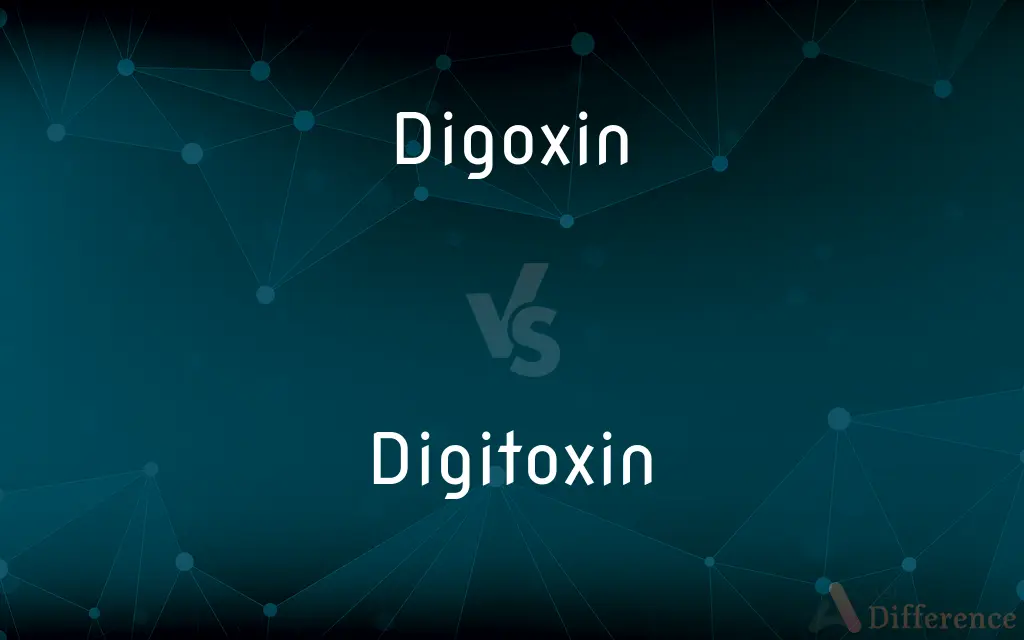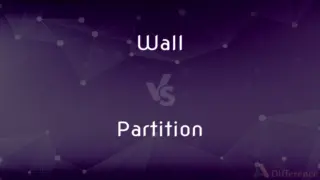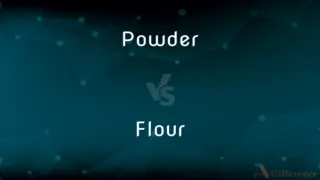Digoxin vs. Digitoxin — What's the Difference?
Edited by Tayyaba Rehman — By Maham Liaqat — Updated on March 29, 2024
Digoxin and digitoxin are both cardiac glycosides used to treat heart conditions, but digoxin is more widely used due to its shorter half-life and better renal clearance.

Difference Between Digoxin and Digitoxin
Table of Contents
ADVERTISEMENT
Key Differences
Digoxin is a cardiac glycoside primarily used to treat heart failure and atrial fibrillation by increasing the force of heart contractions and controlling heart rate. It has a relatively short half-life, which allows for more flexibility in dosing and adjustments based on patient response. On the other hand, digitoxin, also a cardiac glycoside with similar therapeutic aims, has a much longer half-life, leading to a prolonged duration of action and a greater risk of accumulation in the body, especially in patients with renal impairment.
In terms of pharmacokinetics, digoxin is eliminated mainly by the kidneys, which necessitates dose adjustments in patients with renal dysfunction. Whereas digitoxin undergoes extensive metabolism in the liver, with renal excretion playing a lesser role. This difference in metabolism and excretion affects how each drug is monitored and dosed in clinical practice. Digoxin's renal clearance means that its levels can be significantly affected by kidney function, while digitoxin's hepatic metabolism makes it potentially more suitable for patients with renal issues, albeit with careful monitoring due to its long half-life.
Digoxin's therapeutic window is narrow, meaning the difference between a therapeutic dose and a toxic dose is small. This necessitates regular monitoring of blood levels to avoid toxicity. Digitoxin also has a narrow therapeutic index but its longer half-life means that blood levels plateau at a steady state, potentially reducing the frequency of monitoring once the therapeutic dose is established. However, this also means that if toxicity does occur, it takes longer to reduce digitoxin levels in the body.
In clinical use, digoxin is preferred for most patients due to its shorter half-life, which allows for quicker dosing adjustments and a reduced risk of long-term accumulation. Digitoxin, while less commonly used, may still be chosen in specific cases where its pharmacokinetic properties offer distinct advantages, such as in patients with poor renal function who cannot be closely monitored.
The choice between digoxin and digitoxin may also be influenced by the specific cardiac condition being treated, patient comorbidities, and the potential for drug interactions. Digoxin's interactions with other drugs that affect renal function can be particularly significant, while digitoxin's metabolism by the liver introduces considerations for interactions with drugs that influence hepatic enzymes.
ADVERTISEMENT
Comparison Chart
Half-life
Short (36 to 48 hours)
Long (4 to 7 days)
Elimination
Primarily renal
Primarily hepatic, with some renal
Therapeutic Use
Heart failure, atrial fibrillation
Heart failure, atrial fibrillation
Dosing Flexibility
Higher, due to shorter half-life
Lower, due to longer half-life
Risk of Accumulation
Lower, especially with renal impairment
Higher, prolonged duration of action
Monitoring
Requires frequent monitoring due to narrow therapeutic window
Less frequent monitoring once steady state is achieved
Preferred Patient Population
Wider use in general population, especially those with variable renal function
May be considered for patients with stable conditions and less frequent monitoring needs
Compare with Definitions
Digoxin
A medication for heart failure.
Digoxin improves symptoms in patients with chronic heart failure.
Digitoxin
A less commonly used cardiac glycoside.
Digitoxin is selected for specific patients with heart failure.
Digoxin
Renally excreted.
Due to its renal clearance, digoxin dosing must be adjusted in renal impairment.
Digitoxin
Hepatically metabolized.
Digitoxin's metabolism makes it a consideration for patients with renal issues.
Digoxin
Used in atrial fibrillation.
Digoxin helps control heart rate in patients with atrial fibrillation.
Digitoxin
Longer half-life.
Digitoxin's long half-life necessitates careful dose management to avoid toxicity.
Digoxin
Narrow therapeutic window.
Monitoring digoxin levels is crucial to avoid toxicity.
Digitoxin
Used with caution.
The risk of accumulation makes careful monitoring of digitoxin essential.
Digoxin
Shorter half-life.
The shorter half-life of digoxin allows for flexible dosing adjustments.
Digitoxin
Treats heart conditions.
Like digoxin, digitoxin increases the force of heart contractions.
Digoxin
Digoxin, sold under the brand name Lanoxin among others, is a medication used to treat various heart conditions. Most frequently it is used for atrial fibrillation, atrial flutter, and heart failure.
Digitoxin
Digitoxin is a cardiac glycoside. It is a phytosteroid and is similar in structure and effects to digoxin (though the effects are longer-lasting).
Digoxin
A poisonous compound present in the foxglove and other plants. It is a steroid glycoside and is used in small doses as a cardiac stimulant.
Digitoxin
A highly active glycoside, C41H64O13, derived from digitalis and prescribed in the treatment of certain cardiac conditions.
Digoxin
A cardiac glycoside, C41H64O14, obtained from the leaves of a foxglove, Digitalis lanata, with pharmacological effects similar to digitalis.
Digitoxin
(organic compound) A toxic cardiac glycoside, obtained from digitalis, related to cardenolide.
Digoxin
A poisonous compound present in the foxglove (Digitalis lanata) and other plants. It is a steroid glycoside and is used in small doses as a cardiac stimulant.
Digitoxin
A steroid glycoside, one of the cardiotonic chemical substances which is extracted from the foxglove. It is a white, crystalline substance (C41H64O13), and is a 3-substituted triglucoside of a steroid, related structurally to digitalin and digoxin. It is used as a cardiotonic for treatment of certain heart conditions, such as congestive heart failure. Chemically it is (3
Digoxin
A steroid glycoside, one of the cardiotonic chemical substances which is extracted from the foxglove. It is a white, crystalline substance (C41H64O14), and is a 3-substituted triglucoside of a steroid, related structurally to digitalin and digitoxin. It is used as a cardiotonic for treatment of certain heart conditions, such as congestive heart failure. Chemically it is (3
Digitoxin
Digitalis preparation used to treat congestive heart failure or cardiac arrhythmia
Digoxin
Digitalis preparation (trade name Lanoxin) used to treat congestive heart failure or cardiac arrhythmia; helps the heart beat more forcefully
Common Curiosities
Why is monitoring important for patients on digoxin?
Due to its narrow therapeutic window, regular monitoring of digoxin levels is essential to prevent toxicity.
Can digitoxin be used in patients with kidney problems?
Yes, digitoxin may be considered for patients with renal issues due to its primary hepatic metabolism, but it requires careful monitoring because of its long half-life.
What makes digitoxin less preferred than digoxin?
Digitoxin's longer half-life and the associated risk of drug accumulation and toxicity make it less preferred compared to digoxin for most patients.
Can digoxin interact with other medications?
Yes, digoxin can interact with various medications, especially those that affect renal function, which can impact its levels and effectiveness.
What is digoxin used for?
Digoxin is used to treat heart failure and atrial fibrillation by improving heart function and controlling heart rate.
What is the main difference between digoxin and digitoxin?
The main difference lies in their pharmacokinetics; digoxin has a shorter half-life and is primarily renally excreted, whereas digitoxin has a longer half-life with mainly hepatic metabolism.
How should digoxin toxicity be treated?
Treatment may include discontinuing the drug, administering digoxin-specific antibodies, and supportive care, depending on the severity of symptoms.
Is digoxin safe for all patients?
While digoxin is widely used, it requires careful dosing and monitoring, especially in patients with renal impairment or those at risk of toxicity.
How are digoxin and digitoxin doses determined?
Doses are determined based on the patient's condition, kidney function (for digoxin), liver function (for digitoxin), and monitoring of blood levels to avoid toxicity.
How do digoxin and digitoxin work?
Both drugs work by increasing the force of heart muscle contractions and controlling the heart rate, improving symptoms in patients with heart failure and atrial fibrillation.
What are the signs of digoxin toxicity?
Signs include nausea, vomiting, dizziness, confusion, and visual disturbances, necessitating immediate medical attention.
Why is digitoxin considered for patients with stable conditions?
Its longer half-life and less frequent need for dose adjustment make it suitable for patients with stable conditions who require less frequent monitoring.
Are there alternatives to digoxin and digitoxin for heart failure?
Yes, there are several other medications and treatment options for heart failure, including ACE inhibitors, beta-blockers, and diuretics, depending on the specific needs and condition of the patient.
How quickly do digoxin and digitoxin take effect?
Both drugs have a relatively quick onset of action, with effects noticeable within hours, though the full therapeutic effect may take longer to establish.
Can digoxin and digitoxin be used together?
Typically, they are not used together due to their similar mechanisms of action and the increased risk of toxicity; treatment usually involves one or the other, not both.
Share Your Discovery

Previous Comparison
Wall vs. Partition
Next Comparison
Powder vs. FlourAuthor Spotlight
Written by
Maham LiaqatEdited by
Tayyaba RehmanTayyaba Rehman is a distinguished writer, currently serving as a primary contributor to askdifference.com. As a researcher in semantics and etymology, Tayyaba's passion for the complexity of languages and their distinctions has found a perfect home on the platform. Tayyaba delves into the intricacies of language, distinguishing between commonly confused words and phrases, thereby providing clarity for readers worldwide.













































